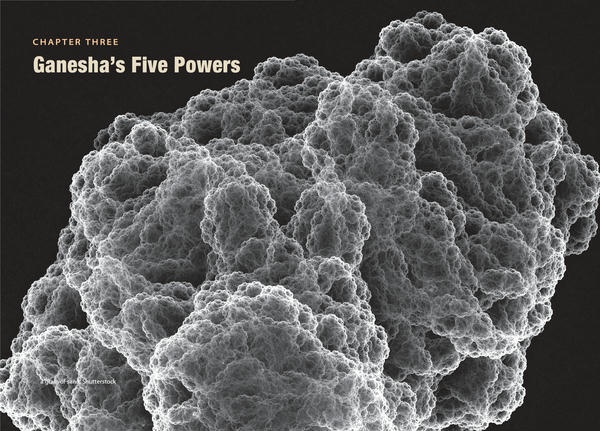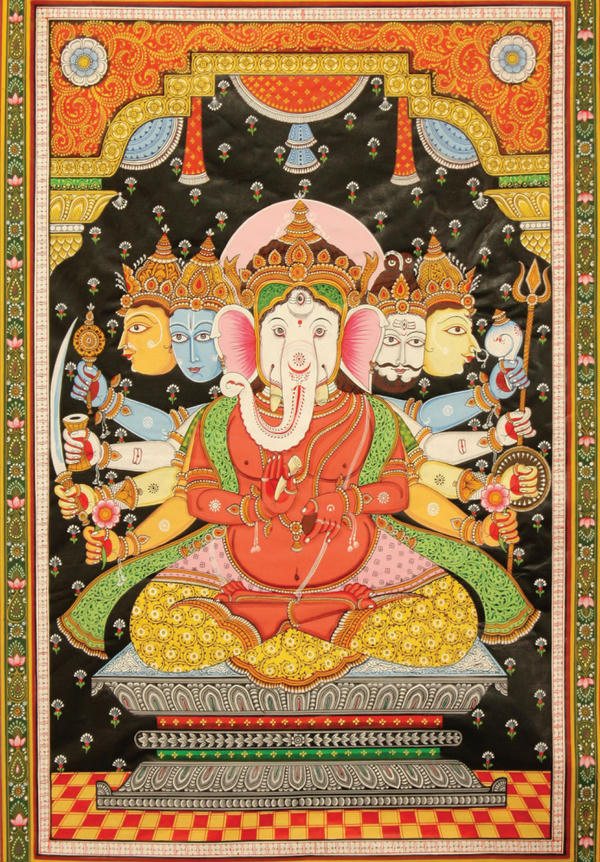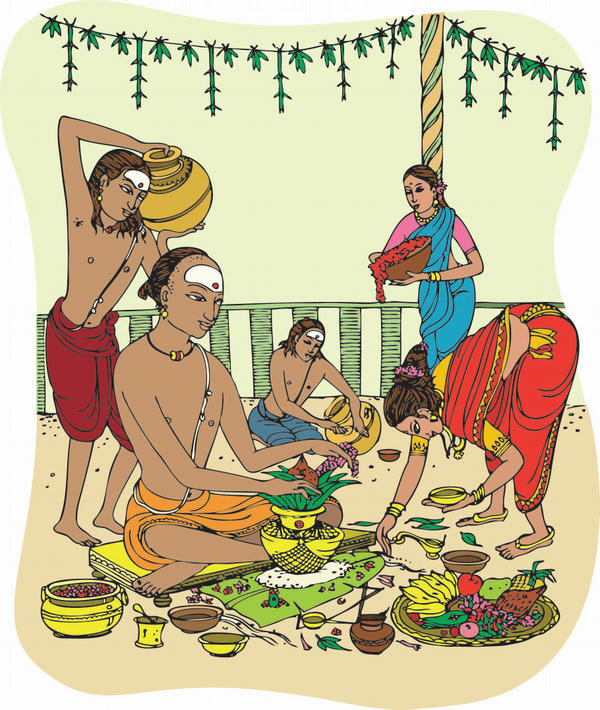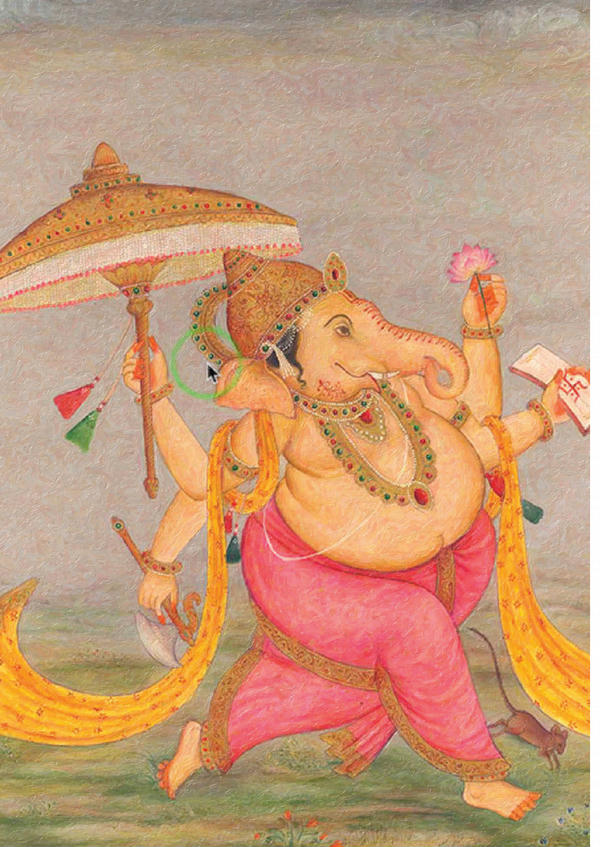Gaṇeśa’s Five Powers§
Śrī Gaṇeśasya Pañchaśaktayaḥ§
श्रीगणेशस्य पञ्चशक्तयः§
 OME, NOW LET US TURN OUR HEARTS AND MINDS TO THE FIVE POWers of Lord Gaṇeśa. Devotees have asked for elucidation of the five profound ways this Great God functions in helping us from the inner worlds. For many Hindus in both the East and the West it is this understanding of the five powerful positive powers, or śaktis, of Lord Gaṇeśa and their five powerful asuric counterforces that makes religion a working part of the devotee’s life and a stabilizing force within the extended family—which embraces kindred, friends, community elders and close business associates. This knowledge and practical experience has helped them understand just how intimately Lord Gaṇeśa works with each of us every day in even our mundane life.§
OME, NOW LET US TURN OUR HEARTS AND MINDS TO THE FIVE POWers of Lord Gaṇeśa. Devotees have asked for elucidation of the five profound ways this Great God functions in helping us from the inner worlds. For many Hindus in both the East and the West it is this understanding of the five powerful positive powers, or śaktis, of Lord Gaṇeśa and their five powerful asuric counterforces that makes religion a working part of the devotee’s life and a stabilizing force within the extended family—which embraces kindred, friends, community elders and close business associates. This knowledge and practical experience has helped them understand just how intimately Lord Gaṇeśa works with each of us every day in even our mundane life.§
There are five great śaktis of Lord Gaṇeśa, as He Himself explained. Their positive vibratory rates can be felt through your astral and physical body and should always be with you. “What is this śakti?” you may be wondering. It is being in the presence of Divinity. All holy men and women emanate all of these śaktis, and you can, too, some stronger than others. Śakti is divine radiation from the Third World through the Second World into the First. The astral body is in the Second World and lives inside the physical body. It is through the astral body that śakti is felt. The śakti comes from the Third World and permeates the astral body in the Second World. This is why the physical body sometimes seems to feel “filled up” with śakti from deep within, permeating out to the inside of our skin. Deeply awakened souls become so filled with the śakti of the Divine that it permeates as cosmic rays out through the skin to the perimeter of the aura, the colorful film of light that surrounds the body. It is felt by other people and attributed as a personal darśana.§
Thus it can be said that Lord Gaṇeśa has five aspects to His presence. Feeling the presence of the benevolent and beneficent Deity Gaṇeśa everywhere is the exemplary example of what each soul wishes to attain. His five powers could well be called “the feet of the Lord,” for it is at these feet that we sit and worship, bringing harmony to our home, among our relatives and friends and business associates, bringing culture, creativity and religion into our life. Crowned by a heartfelt love of God that we then give forth, we are then allowed to perform charities and, in overflowing abundance, prepare the religious edifices for the next generation. Experiencing this personally will take daily meditation.§
THE FIRST ŚAKTI§
The first śakti emanates the feeling of love and compassion that the good person naturally has for his or her immediate family. Love and harmony within the nuclear or joint family is most important to all Hindus, and the beautiful feeling when it exists is the first śakti of the Lord. If love abounds in the home and virtue prevails, the home is perfect and its end fulfilled.§
THE SECOND ŚAKTI§
The second śakti is the same feeling but extended to relatives, neighbors and friends, all who are part of the extended family. This is more difficult to hold, as inharmonious conditions often arise. These are called asuric forces, which come between people, causing misunderstanding and upsets. Through prayers and through worship, the first śakti can be extended beyond the circumference of the immediate family to include acquaintances, relatives and friends. When this vibration of harmony is felt, all the power of the Lord is with you, as the first śakti and the second śakti merge, bringing in abundance the onrush of the third śakti.§
THE THIRD ŚAKTI§
The third śakti of Lord Gaṇeśa is this same love extended to all persons one has dealings with in the external world: business associates, a casual merchant and the public at large. It is honest and harmonious relationships in conducting the business of trade and dealings in goods, finance and the distribution of the wealth of the world. This is a most important vibration to be felt, and constantly felt. This śakti of the Lord is tenuous to hold onto, for worldly and materialistic forces, as you well know, militate against this kind of harmony. But once these lower powers are conquered, worries cease, concerns are alleviated and heartfelt joy comes. Such is the grace of loving Gaṇeśa. As the Tirukural (120) declares, “Those businessmen will prosper whose business protects as their own the interests of others.”§
THE FOURTH ŚAKTI§
The fourth śakti is an outpouring from having held fast to the first three. It is a combination of the first two śaktis, stabilized by the third. The fourth śakti of Lord Gaṇeśa brings through the creative-intuitive mind—the love of culture and all that it brings, religious formalities and the respect and appreciation of discipline. Here we find the vibration of religion, which brings as a boon creativity in music, art, drama and the dance. It is through these refining rays that religious life is adhered to and congested forces are braided together in a harmonious pattern for a glorious future. It is through the fourth śakti that religious practices are performed consistently and the refinements of the past are carried into the future. It also extends to devotion toward one’s ancestors and all forms of positive community participation.§
THE FIFTH ŚAKTI§
The fifth śakti of Lord Gaṇeśa is the combination of the first and the third in vibration, and it extends into the wonderful feelings obtained by the outpouring of love of this God. Loving Lord Gaṇeśa with all your heart and soul is the combined merging of these five śaktis. This gives the added boon of being able to be charitable; for those who love God perform charity, build shrines and temples and participate in the overflowing generosity from their resources, earning abundant puṇya, fine merit, accrued for this life and passed on to the next. We can see that harmony within the immediate family and harmony extended to all business associates creates the spiritual dynamic within the individual and the group to burst forth into loving this benign God and receiving His material, emotional, intellectual and spiritual abundance.§
The Hindu soul who is immersed in the love of the Lord of Obstacles knows he is not the giver, but only the channel for the giving. He is intuitively aware of the māyā of his existence, yet acutely aware of the necessity of sharing his natural, blissful state of having become one with this Lord through the first five śaktis. Such a devotee is the pillar of the temple, the protector of the sādhaka, the respecter of the priesthood and the obedient slave to the holy scriptures, and is seen by all as the compassionate one. Being free in mind, emotion and body, the family that lives basking in the five śaktis of Gaṇeśa performs daily pūjā and yearly pilgrimage while upholding the five obligations, the pañcha nitya karmas, of the Hindu with joyous ease.§
THE SIXTH, SEVENTH AND EIGHTH ŚAKTIS§
You may be wondering what lies beyond these first five vibratory rates. Three more śaktis are yet to be unfolded, which we shall do here but briefly.§
The sixth śakti, entrusted to Lord Murugan, is that of rāja yoga, the awakening of the kuṇḍalinī, which should never be attempted until the first five vibratory rates of the Lord have been maintained and are a natural part of one’s life. The sixth śakti is only felt in yogic meditation, when the crown of the head becomes the temple—the high-pitched “eee” tone ringing within it like a temple bell, and the kuṇḍalinī awakened, the camphor light aglow. The yogī thus locked in his own yoke finds himself seated on the fifth śakti, supported by the lotus petals of the other four. In his state of yoga, he then merges into jñāna; and answers to his deepest philosophical questions come crystal clear as the seventh śakti penetrates the ākāśic ether of his mind.§
The seventh śakti is the great ray of the giving forth of spiritual teachings from the brink of the Absolute, at which point Lord Śiva and His son Lord Murugan merge. This great śakti is held by the ṛishis and the saints of our religion. Lord Murugan Himself is the preceptor of all of our religion. The seventh and eighth śaktis are the Śiva-Śakti, the great dance of creation, the eighth being that outpouring power felt when mind collects itself when it comes out of the Self, the Absolute, and then forms into manifest knowledge: the seventh śakti.§
We shall not concern ourselves now with the sixth, seventh or eighth śaktis, for we are to meditate on and bring through the rays of the first five śaktis through the worship of Lord Gaṇeśa. These five śaktis form the basis for all of the religions in the world, though usually not in their entirety. What we call Gaṇeśa worship today is actually the age-old religious pattern performed through eons of time and found in some form in each of the eleven religions of the world and in the multitudes of faiths. The height of religious experience in many religions is to uphold these five śaktis for society to survive and flourish. And this is basically the extent of most of the world’s religions; for once religion is secured in one’s life, rāja yoga—finding the temple within, going into that temple, merging within the sanctum sanctorum with the Supreme Lord Himself, the father of the great God Gaṇeśa—is the next and most natural unfoldment.§
The Hindu who takes such steps into the realms of Lord Murugan, God of all yoga, son of Śiva, can rely upon the firm foundation of the first five śaktis, which are maintained within him through his personal association with Lord Gaṇeśa. Thus, if he falters in his practice of yoga, he does not fall into an abyss. One who does not have the five śaktis firmly established in life should not perform the more rigorous yogas, lest he awaken and invoke the asuric, antagonistic forces of the lower worlds which have the power to counteract and nullify all of one’s previous positive efforts.§
Sealing off the Lower Realms§
The higher one climbs toward the summit of Truth, the deeper the abyss that lies below, should he stumble and fall from the path. What happens when seekers on the path lapse and detour into lower worlds of contemptuous behavior toward themselves as well as others? Low self-esteem, loneliness, fear, unfounded guilt and remorse all are symptoms of the abyss of consciousness so feared by devas and humans alike, and described in scripture and protected against by spiritual preceptors. It is plain to see that the doors of the chakras below the mūlādhāra must be firmly closed, sealed off, before serious yoga practice is sought for or performed.§
The Five-Fold Abyss§
What is the abyss? It is the way of adharma and the fate of those who neglect religious practices or fall from any vows they may have taken along the way. There are five abysses, and they are the exact opposites in vibration to the first five śaktis so carefully guarded by Lord Gaṇeśa.§
THE FIRST ABYSS§
The first abyss is inharmonious conditions within the home, fighting and squabbling among those who are near and dear to each other. This makes strong saṁskāras, or scars, in the subconscious mind and begins to create a subconscious that opposes any kind of furtherance of religious life. The first, therefore, is the deepest abyss and the most difficult to rise out of.§
THE SECOND ABYSS§
The second abyss is inharmonious conditions and misunderstandings—allowed to exist without apology, recompense or forgiveness—between acquaintances, friends and relatives not living in the immediate home. It is easier to scale the walls of this abyss; it takes a little humility to do so, some understanding and kindness. Lord Gaṇeśa is expert in retrieving souls who invoke His guidance, for He is a Mahādeva who could well be called the master of the conscious and subconscious states of mind. Therefore, Hindus go to Him in all worldly matters. This asuric force, propelled by entities of the lower astral, is one which stimulates deteriorating gossip about family and social relationships outside the home. It could cause a wife to speak ill of her husband to a neighbor. It would provoke the spreading of lies about an individual to ostracize him or her from the community or social set.§
THE THIRD ABYSS§
The third abyss is that of worry and trouble. The courts of law handle this one, the collection agencies—and displeased customers. Lack of courtesy in business affairs, the borrowing and the lending of money all together throw their power into making a luscious, comfortable, luxurious abyss of inharmonious conditions within the business world. This asuric force stimulates dishonest business dealings, taking advantage of goodwill and trust an establishment has extended. Not honoring commitments when expected is the devilish force that antagonizes. This force also separates people through misunderstanding, causing them to dislike one another. Many people live in this abyss throughout their entire life. It is a welcoming capacious pit that the gravity of desire constantly leads one into. There are many asuric people within it to torture as they entertain. However, an escape is available even from this abyss through the careful handling of one’s business affairs and consistent religious practice, seeking the help of Lord Gaṇeśa all the way. Within each of these first three pits are asuric people on the lower astral plane who aid in distressing the dreams at night; and the vibration within these three abysses is terrible.§
THE FOURTH ABYSS§
The fourth abyss is a most treacherous one; and even though some may have avoided falling in the first three, they may still find themselves in this one, turning their back on culture, scholarship, serious literature and philosophy, despising music, art, drama and the dance, ridiculing religious people and their practices, content with the libertine, dull, drab life of material things. Sloth and conceit are found here, along with the smug attitudes of those that have the first three śaktis well under control. Here their intellect is God to them; here money is God to them. The reliance on intellect and wealth within this abyss makes it difficult to perceive that someone is there. But being graced with an educated intellect and/or wealth, and perhaps a shallow religious nature, void of deep, heartfelt understanding, the lack of creativity, refined sensibilities and love of God is the key to knowing that, indeed, the fourth abyss lays claim to the soul. This abyss of worldliness could well become the constant fulfillment of desires, one after another, only for the sake of desires and their fulfillment.§
This asuric force and its representatives on the inner and outer planes, spiritual anacharists and, worse, mercenary terrorists with no desire for a better society, bring the breakdown of religiousness, art, culture and the heritage of the past. In the inner worlds these are well-trained entities, intelligent beings skilled in the black arts, conspiring with human counterparts on the physical plane to bring down the nature of humanity to a base level. They have dedicated themselves to destruction for destruction’s sake. If you enter into this abyss and the others, you come under their control and become their pupils. This power breeds promiscuity between the sexes and drains the life of man, bringing him firmly into his animal nature, resulting in loss of conscience. When he loses conscience, he no longer suffers remorse or repents for his misdeeds; and hence an asuric culture is born for the many who participate in it. Ancestry is forgotten and the ways of the past are put down, as no one has time to cultivate the refinement and the arts of yesterday, bringing them into today to preserve them for tomorrow.§
THE FIFTH ABYSS§
The fifth abyss is the dismal condition one experiences when devoid of the childlike spontaneity of spiritual giving, worship and religous service. When this abyss grips and shrouds the soul, it disables him from spontaneous participation in all kinds of religious festivals and events as the opportunities present themselves around the years. The negative vibration felt by the person who feels nothing when he goes to the temple, sees the Deity as a piece of stone or metal, who observes and faults those around him, is as powerful a feeling as that felt by the devotee standing next to him who is moved to tears because of his love of God—this is the mystery of the fifth śakti and its corresponding enshrouding abyss.§
Consciously Tuning in to the Five Śaktis§
To bring religion into one’s life requires the worship of Lord Gaṇeśa and the daily tuning in to these five great śaktis. This worship brings harmony to our home, to our relatives and friends and to business associates. It brings culture, creativity and religion into our life. All this is crowned by such a heartfelt love of God that we can then give forth. We are allowed to perform charities and, in overflowing abundance, prepare the religious edifices for the next generation. This is what our daily pūjās and meditation, our pilgrimages and other religious practices serve to manifest in our lives.§
The Five Śaktis of Lord Gaṇeśa§
A Reverent Doxology by a Śaiva Paramāchārya§
Loving Ganesha! Dear to Siva’s men,
Within whose form the world of form resides,
Who earned the mango by a pond'rous ken
And made the moon to wax and wane in tides.§
Aum Ganesha! Loved by saints and sages,
Whose skillful arms five potent shaktis wield
To guide men now as in forgotten ages—
The seeker’s shield, the farmer’s fertile field.§
Aum! Ganesha’s first shakti is home life,
Protection, harmony, fertility—
Respect becomes the man, as love the wife,
Obedience their cherished offspring’s glee.§
Aum! Ganesha’s second shakti’s family—
By blood, by marriage and proximity.
Word and thought controlled, like minds agree,
While faithful friends preserve community.§
Aum! Ganesha’s third shakti’s the market,
Where commerce earns the Earth stability,
Where forthright, selfless merchants, free from debt,
Conceive, produce, exchange prosperity.§
Aum! Ganesha’s fourth shakti brings culture—
Refined expression, graceful artistry
In music, dance, in poetry and sculpture
Or common conduct performed consciously.§
Aum! Ganesha’s fifth shakti is dharma—
Fair merit found in virtue’s charity—
Where love of God conquers ancient karma
And Siva’s slaves earn grace’s rarity.§
Jaya Ganesha! Come, our hearts protect
From discord in the home, from strife with friend,
From business misfortune, from art’s neglect,
From soul’s dark night—these griefs asuric end.§





